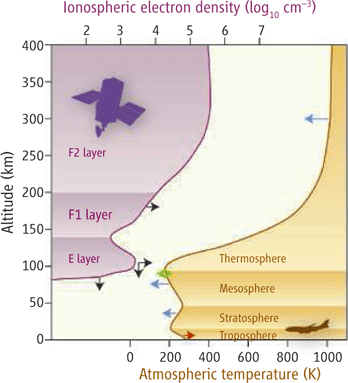
I'm taking a free online class about climate change denial. It's fascinating, and I've only barely half finished the first week's readings.
One of the references at the end of the first half of the week's readings is this one, showing that increasing greenhouse gas is causing changes in the upper atmosphere:
In the "upper atmosphere," from 10 to 300 kilometers high, increasing greenhouse gas (CO2) is causing an increase in density which is in turn causing layers of the sky to "fall." Is this bad? Well, ask Chicken Little. Or take the class (See below).
Here's the graph that accompanies the short article.
It's not too late to sign up for the class. It's in the second week, and I just signed up for it; you can do the first week's work and then continue. If you're interested: "Making Sense of Climate Change Denial." I'm taking it not to learn more about climate science but to learn how to deal with false information I read and hear all the time about the topic. However, I'm learning a lot about climate change, too.
From the "About This Course" info:
In public discussions, climate change is a highly controversial topic. However, in the scientific community, there is little controversy with 97% of climate scientists concluding humans are causing global warming.
This course examines the science of climate science denial.
- Why the gap between the public and scientists?
- What are the psychological and social drivers of the rejection of the scientific consensus?
- How has climate denial influenced public perceptions and attitudes towards climate change?
We will look at the most common climate myths from “global warming stopped in 1998” to “global warming is caused by the sun” to “climate impacts are nothing to worry about.”
We’ll find out what lessons are to be learnt from past climate change as well as better understand how climate models predict future climate impacts. You’ll learn both the science of climate change and the techniques used to distort the science.
With every myth we debunk, you’ll learn the critical thinking needed to identify the fallacies associated with the myth. Finally, armed with all this knowledge, you’ll learn the psychology of misinformation. This will equip you to effectively respond to climate misinformation and debunk myths.
A timely perspective article in Science
this week addresses the issues of upper atmosphere change. ‘Upper’
atmosphere here is the stratosphere up to the ionosphere (~20 to 300
km). Laštovička et al
point out that cooling trends are exactly as predicted by increasing
greenhouse gas trends, and that the increase in density that this
implies is causing various ionspheric layers to ‘fall’. This was
highlighted a few years back by Jarvis et al (1998) and in New Scientist in 1999 (and I apologise for stealing their headline!).
The changes in the figure are related to the cooling seen in the lower stratospheric MSU-4 records (UAH or RSS), but the changes there (~ 15-20 km) are predominantly due to ozone depletion. The higher up one goes, the more important the CO2 related cooling is. It’s interesting to note that significant solar forcing would have exactly the opposite effect (it would cause a warming) – yet another reason to doubt that solar forcing is a significant factor in recent decades.
Update: The best explanation for the cooling trends can be found on ESPERE (alternative site), in particular, figure 3 (alt. version).
- See more at: http://www.realclimate.org/index.php/archives/2006/11/the-sky-is-falling/#sthash.6SDGqLRM.dpuf
The changes in the figure are related to the cooling seen in the lower stratospheric MSU-4 records (UAH or RSS), but the changes there (~ 15-20 km) are predominantly due to ozone depletion. The higher up one goes, the more important the CO2 related cooling is. It’s interesting to note that significant solar forcing would have exactly the opposite effect (it would cause a warming) – yet another reason to doubt that solar forcing is a significant factor in recent decades.
Update: The best explanation for the cooling trends can be found on ESPERE (alternative site), in particular, figure 3 (alt. version).
- See more at: http://www.realclimate.org/index.php/archives/2006/11/the-sky-is-falling/#sthash.6SDGqLRM.dpuf
1 comment:
Josef Goebbels figured that denial part back in 1935. Say something totally untrue loudly enough and long enough, and the people will increasingly believe it.
Arbeit macht frei!
BTW: The New Yorker has a cartoon showing a woman interviewing a smug politician in a 3-piece suit with the Capital Dome in the background. He says "I like to think we aren't so much denying science, as promoting myths."
Post a Comment